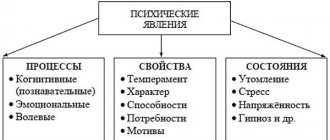Personality is a qualitative individual characteristic that combines stable and permanent mental properties that determine a person’s behavior and attitude. Literally, translated from Greek, character means a sign, a trait. Character in the structure of personality combines the totality of its various qualities and properties that leave an imprint on behavior, activity and individual manifestation. A set of essential, and most importantly, stable properties and qualities determine a person’s entire lifestyle and his ways of reacting in a given situation.
The character of an individual is formed, determined and formed throughout his entire life journey. The relationship between character and personality is manifested in activity and communication, thereby determining typical modes of behavior.
Personality Traits
Any trait is some stable and unchangeable stereotype of behavior.
Characteristic personality traits in a general sense can be divided into those that set the general direction for the development of character manifestations in the complex (leading), and those that are determined by the main directions (minor). Leading traits allow you to reflect the very essence of character and show its main important manifestations. We must understand that any character trait of a person will reflect the manifestation of his attitude to reality, but this does not mean that any of his attitudes will directly be a character trait. Depending on the individual’s living environment and certain conditions, only some manifestations of relationships will become defining character traits. Those. a person may react aggressively to a particular irritant of the internal or external environment, but this will not mean that the person is evil by nature.
In the character structure of each person, there are 4 groups. The first group includes traits that determine the basis of personality, its core. These include: honesty and insincerity, integrity and cowardice, courage and cowardice, and many others. The second includes traits that demonstrate an individual’s attitude directly towards other people. For example, respect and contempt, kindness and anger, and others. The third group is characterized by the individual’s attitude towards himself. It includes: pride, modesty, arrogance, vanity, self-criticism and others. The fourth group is the attitude towards work, activity or work performed. And it is characterized by such traits as hard work and laziness, responsibility and irresponsibility, activity and passivity, and others.
Some scientists additionally identify another group that characterizes a person’s attitude towards things, for example, neatness and sloppiness.
They also distinguish such typological properties of character traits as abnormal and normal. Normal traits are characteristic of people who have a healthy psyche, while abnormal traits include people with a variety of mental illnesses. It should be noted that similar personality traits can be considered both abnormal and normal. It all depends on the degree of expression or whether it is an accentuation of character. An example of this could be healthy suspicion, but when it goes off scale, it leads to paranoia.
The determining role in the formation of personality traits is played by society and a person’s attitude towards it. It is impossible to judge a person without seeing how he interacts with the team, without taking into account his attachments, dislikes, comradely or friendly relations in society.
An individual's attitude towards any type of activity is determined by his relationships with other persons. Interaction with other people can encourage a person to be active and rationalize, or keep him in tension and give rise to his lack of initiative. An individual's idea of himself is determined by his relationships with people and his attitude to activity. The basis in the formation of personality consciousness is the direct relationship to other individuals. A correct assessment of another person’s personality traits is a fundamental factor in the formation of self-esteem. Also, it should be noted that when a person’s activity changes, not only the methods, methods and subject of this activity change, but also the person’s attitude towards himself in the new role of an actor changes.
Personality traits
The main feature of character in the personality structure is its certainty. But this does not mean dominance of one trait. Several traits, contradicting or not contradicting each other, can dominate a character. Character can lose its definition in the absence of clearly defined traits. The system of moral values and beliefs of an individual is also a leading and determining factor in the formation of character traits. They establish the long-term direction of individual behavior.
The character traits of an individual are inextricably linked with his stable and deep interests. The lack of integrity, self-sufficiency and independence of the individual is closely related to the instability and superficiality of the individual’s interests. And, conversely, a person’s integrity and purposefulness and perseverance directly depend on the content and depth of his interests. However, similarity of interests does not yet imply similarity of characteristic personality traits. For example, among scientists you can meet both cheerful and sad people, both good and evil.
To understand the characteristics of a person’s character, one should also pay attention to his affections and leisure time. This can reveal new facets and characteristics of character. It is also important to pay attention to the compliance of a person’s actions with his established goals, because an individual is characterized not only by actions, but also by how exactly he produces them. The direction of activity and the actions themselves form the dominant spiritual or material needs and interests of the individual. Therefore, character should be understood only as the unity of the image of actions and their direction. It is on the combination of personality traits and his properties that a person’s real achievements depend, and not on the presence of mental capabilities.
Temperament and personality
The relationship between character and personality is also determined by the individual’s temperament, abilities and other aspects. And the concepts of temperament and personality form its structure. Character is a set of qualitative properties of an individual that determine his actions, manifested in relation to other people, actions, and things. Whereas temperament is a set of mental properties of an individual that influence his behavioral reactions. The nervous system is responsible for the manifestation of temperament. Character is also inextricably linked with the individual’s psyche, but its traits develop throughout life under the influence of the external environment. And temperament is an innate parameter that cannot be changed, you can only restrain its negative manifestations.
The prerequisite for character is temperament. Temperament and character in the personality structure are closely interrelated with each other, but at the same time they are different from each other.
Temperament embodies mental differences between people. It varies in depth and strength of manifestations of emotions, activity of actions, impressionability and other individual, stable, dynamic characteristics of the psyche.
We can conclude that temperament is the innate foundation and basis on which the personality is formed as a member of society. Therefore, the most stable and permanent personality traits are temperament. It manifests itself equally in any activity, regardless of its focus or content. Remains unchanged in adulthood.
So, temperament is the personal characteristics of an individual, which determine the dynamism of his behavior and mental processes. Those. The concept of temperament characterizes the pace, intensity, duration of mental processes, external behavioral reaction (activity, slowness), but not conviction in views and interests. It also does not determine the value of an individual and does not determine its potential.
There are three important components of temperament that relate to the general mobility (activity) of a person, his emotionality and motor skills. In turn, each of the components has a rather complex structure and is distinguished by various forms of psychological manifestation.
The essence of activity lies in the individual’s desire for self-expression and transformation of the external component of reality. At the same time, the very direction, the quality of implementation of these trends is determined precisely by the characterological characteristics of the individual and not only. The degree of such activity can range from lethargy to the highest manifestation of mobility - constant rise.
The emotional component of a person’s temperament is a set of properties that characterize the characteristics of the course of various feelings and moods. This component is the most complex in its structure compared to the others. Its main characteristics are lability, impressionability and impulsiveness. Emotional lability is the speed with which one emotional state is replaced by another or ceases. Sensibility is understood as the subject’s susceptibility to emotional influences. Impulsivity is the speed with which emotion turns into the motivating reason and force of actions and deeds without first thinking them through and making a conscious decision to carry them out.
The character and temperament of a person are inextricably linked. The dominance of one type of temperament can help determine the character of subjects as a whole.
Leonhard. Classification
Emotive type - communicate only with those people who understand you
Scientists have identified various types that describe character.
- Hyperthymic. Increased contact, talkativeness, pronounced facial expressions. Belongs to energetic optimists. There are disadvantages, namely frivolity in relationships, responsibilities, and frivolity.
- Disthymic. Characterized by low contact, a person of few words, a pessimist. The owner of such a disposition is accustomed to obey. The disadvantages are slowness. The advantages are conscientiousness, a serious sense of justice.
- Excitable. Characterized by low contact, there is boringness.
- Cycloid. Mood swings are typical. A person who is either overly sociable or withdrawn.
- Stuck. Moderate sociability, boring. People are touchy, conflict-ridden, and highly sensitive to injustice. Such persons want to achieve high results, in any field.
- Pedantic. Excessive zeal in service, constant tediousness, seriousness, conscientiousness.
- Emotive. The desire to communicate only with those people who understand him well. Overly sensitive people, touchy, whiny, are in a depressed mood. Pros include being compassionate as well as being diligent.
- Anxious. Low contact, indecisiveness. Such people very rarely enter into conflict. They are friendly, efficient and self-critical.
- Demonstrative. Such special ones strive to be in first place, crave power, are very sociable, and easily adapt when communicating with new people. However, hypocritical people are often selfish. The advantages include extraordinary thinking and artistry.
- Exalted. Increased desire to talk, falling in love. They can also be quite conflicting. They are attentive to close people and have sincere feelings. The disadvantages include alarmism and desperation.
- Introverted. Low level of contact, characterized by isolation from the real world and isolation. Such people are prone to loneliness, introspection, and are principled.
- Extroverted. Open to new information, they will always listen and help. They are very efficient and talkative. The disadvantages include rashness of actions, frivolity, and a tendency to gossip.
Personality types
Today in the specific literature there are many criteria by which personality types are determined.
The typology proposed by E. Kretschmer is now the most popular. It consists of dividing people into three groups depending on their physique.
Picnic people are people who tend to be overweight or slightly overweight, short in stature, but with a large head, wide face and short neck. Their character type corresponds to cyclothymics. They are emotional, sociable, and easily adapt to a variety of conditions.
Athletic people are tall and broad-shouldered people, with well-developed muscles, a resilient skeleton and a powerful chest. They correspond to the ixothymic type of character. These people are powerful and quite practical, calm and unimpressive. Ixothymic people are restrained in their gestures and facial expressions and do not adapt well to changes.
Asthenic people are people who are prone to thinness, their muscles are poorly developed, their chest is flat, their arms and legs are long, and they have an elongated face. Corresponds to the schizothymic character type. Such people are very serious and prone to stubbornness, and have difficulty adapting to change. Characterized by isolation.
K.G. Jung developed a different typology. It is based on the predominant functions of the psyche (thinking, intuition). His classification divides subjects into introverts and extroverts depending on the dominance of the external or internal world.
An extrovert is characterized by directness and openness. Such a person is extremely sociable, active and has many friends, comrades and just acquaintances. Extroverts love to travel and get everything out of life. An extrovert often becomes the initiator of parties; in companies, he becomes their soul. In ordinary life, he focuses only on circumstances, and not on the subjective opinion of others.
An introvert, on the contrary, is characterized by isolation and turning inward. Such a person isolates himself from the environment and carefully analyzes all events. An introvert has a hard time making contact with people, so he has few friends and acquaintances. Introverts prefer solitude to noisy companies. These people have an increased degree of anxiety.
There is also a typology based on the relationship between character and temperament, which divides people into 4 psychotypes.
A choleric person is a rather impetuous, fast, passionate and at the same time unbalanced person. Such people are subject to sudden mood swings and emotional outbursts. Cholerics do not have a balance of nervous processes, so they quickly become exhausted, thoughtlessly wasting their strength.
Phlegmatic people are distinguished by equanimity, unhurriedness, stability of moods and aspirations. Outwardly, they practically do not show emotions and feelings. Such people are quite persistent and persistent in their work, while always remaining balanced and calm. The phlegmatic person compensates for his slowness in work with diligence.
A melancholic person is a very vulnerable person, prone to stable experiences of various events. A melancholic person reacts sharply to any external factors or manifestations. Such people are very impressionable.
A sanguine person is a mobile, active person with a lively character. He is subject to frequent changes of impressions and is characterized by rapid reactions to any events. We can easily relate to the failures or troubles that befell him. When a sanguine person is interested in his work, he will be quite productive.
Also, K. Leonhard identified 12 types, often found in people with neuroses, accentuated characters. And E. Fromm described three social types of characters.
Biological basis of character structure
The basis of character is the innate characteristics of higher nervous activity:
- speed of nervous processes;
- the strength of these processes;
- the ratio of excitation and inhibition in the nervous system.
The combination of these features constitutes the temperament or type of higher nervous activity of a person. There are only 4 types of temperament (phlegmatic, melancholic, sanguine and choleric), but in their pure form they are practically never found. These are complexes of traits, features of higher nervous activity that are present in humans in different combinations and varying degrees of severity. That is, if we take, for example, such a paired characteristic as introversion-extroversion, then a person can be more or less an extrovert or an introvert.
And there are several such characteristics that make up temperament. For example:
- rigidity and plasticity;
- emotional stability and emotional imbalance, sensitivity (sensitiveness), etc.
Due to their combination, a unique biological basis for character is created, and in the process of its formation, innate individual psychological traits are melted under the influence of the environment, mixed with social qualities, acquired properties, characteristics, and a completely unique personality is created.
Psychological character of personality
Everyone has long known that significant changes occur in the psychological character of an individual in the process of its development and life activity. Such changes are subject to typical (natural) and atypical (individual) trends.
Typical trends include changes that occur in psychological character as a person grows older. This happens because the older an individual becomes, the faster he gets rid of childish manifestations in character, which distinguish childish behavior from adult behavior. Childhood personality traits include capriciousness, tearfulness, fears, and irresponsibility. Adult traits that come with age include tolerance, life experience, rationality, wisdom, prudence, etc.
As an individual moves along the path of life and gains life experience, changes occur in their views on events, and their attitudes towards them change. Which together also influences the final formation of character. Therefore, there are certain differences between people of different age groups.
For example, people between the ages of approximately 30 and 40 live mainly in the future; they live in ideas and plans. All their thoughts, their activities are aimed at realizing the future. And people who have reached 50 years of age have approached the point where their present life meets simultaneously with their past life and their future. And therefore, their character is modified in such a way as to correspond to the present. This is the age when people completely say goodbye to their dreams, but are not yet ready to be nostalgic for the years they have lived. People who have passed the 60-year mark practically no longer think about the future; they are much more concerned about the present, and they have memories of the past. Also, due to physical ailments, the previously taken pace and rhythm of life is no longer available to them. This leads to the appearance of such character traits as slowness, measuredness, and tranquility.
Atypical, specific tendencies are directly related to events experienced by a person, i.e. conditioned by past life.
As a rule, character traits that are similar to existing ones are consolidated much faster and appear much faster.
You should always remember that character is not an immutable quantity; it is formed throughout a person’s entire life cycle.
Positive human qualities
“The simple fabric of my destiny is embroidered with silks.” Silk threads here are character traits that make a person happy.
- Unselfishness
- Friendliness
- Discretion
- Confidence
- Determination
- Perseverance
- Sincerity
- Optimism
- Respect for others
- Moral
- Honesty
- Responsibility
- Accuracy
- Determination
- Hard work
Read also: How to develop charisma in yourself?
- Courage
- Thrift
- Self-esteem
- Discipline
- Communication skills
- Punctuality
- Politeness
- Kindness
- Cheerfulness
- Responsiveness
- Humor
- Modesty
- Loyalty
- Tolerance
- Justice
- Empathy
- Patience
- Self-criticism
- Good manners
Social character of personality
Individuals of any society, despite their individual personal characteristics and differences, have common psychological manifestations and properties, and therefore act as ordinary representatives of a given society.
The social character of a person is a general way of adapting a person to the influence of society. It is created by religion, culture, education system and family upbringing. It should also be taken into account that even in a family, a child receives an upbringing that is approved in a given society and corresponds to the culture, which is considered normal, ordinary and natural.
According to E. Fromm, social character means the result of a person’s adaptation to a particular way of organizing society, to the culture in which he is brought up. He believes that none of the known developed societies in the world will allow the individual to fully realize himself. From this it turns out that the individual from birth is in conflict with society. Therefore, we can conclude that the social character of an individual is a kind of mechanism that allows an individual to exist freely and with impunity in any society.
The process of adaptation of an individual in society occurs with a distortion of the character of the individual himself and his personality, to the detriment of it. According to Fromm, social character is a kind of defense, an individual’s response to a situation that causes frustration in the social environment, which does not allow the individual to freely express himself and fully develop, placing him obviously within limits and limitations. In society, a person will not be able to fully develop the inclinations and capabilities inherent in him by nature. As Fromm believed, social character is instilled in the individual and has a stabilizing character. From the moment an individual begins to have a social character, he becomes completely safe for the society in which he lives. Fromm identified several options of this nature.
Negative human qualities
Rare parents deliberately cultivate negative qualities in their children. The latter are formed as a reaction of the child’s psyche to the environment in which he lives. Where there is no love, indifference reigns - poisonous flowers of selfishness, laziness, and disorganization grow. Such character traits make a person unlucky. When aggression and depravity rule the roost in a family, children develop meanness, greed, and cruelty—they grow up unhappy.
- Gambling
- Weakness
- Facelessness
- Addiction
- tediousness
- Pettiness
- Greed, stinginess
- Spoiled
- windiness
- Flattery
- Indifference
- Apathy
- Jealousy
- Alarmism
- Complexity
- Lust for power
- Ruthlessness
- Disorderly
- Arrogance
- Self-criticism
- Stubbornness
- Authoritarianism
- Hypocrisy
- Irresponsibility
- Touchiness
- Self-confidence
- Aggressiveness
- Greed
- Deceit
- Selfishness
- Cruelty
- Vanity
- Suggestibility
- Irritability
- Laziness
- Impudence
- vulgarity
- Stupidity
- Rudeness
- Narcissism
- Cowardice
- Pride
- Forgetfulness
- Anger
- Annoyance
- Coarseness
- Extravagance
- Curiosity
- Negligence
- Vindictiveness
- Vulgarity
- Talkativeness
- Envy











